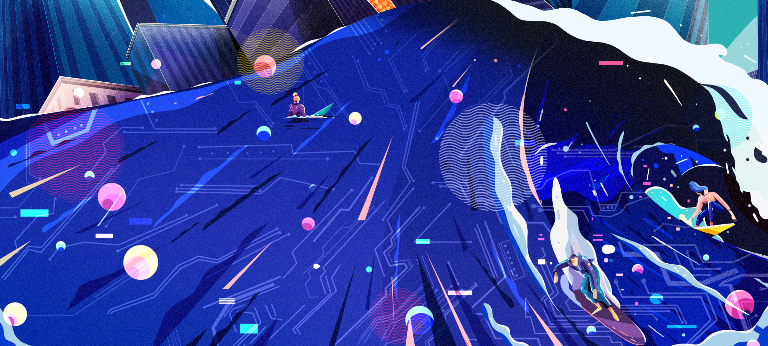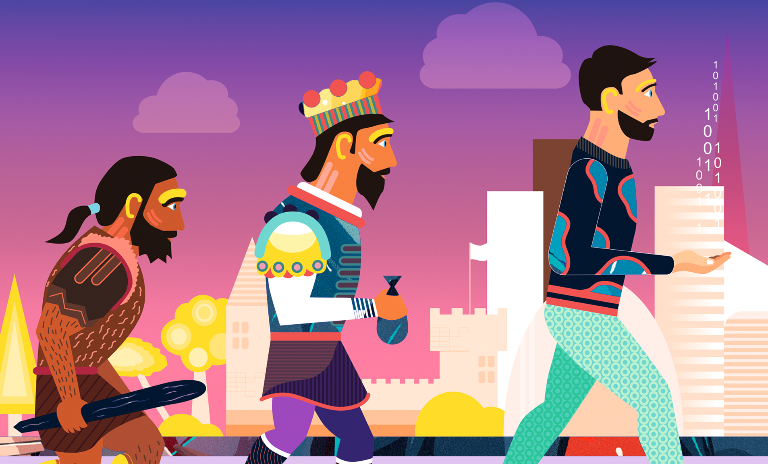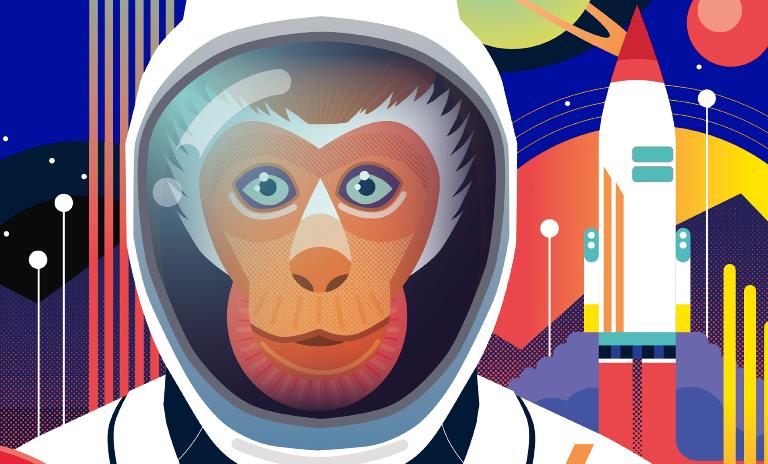How crisis can fast-track business transformation
![{[downloads[language].preview]}](https://www.rolandberger.com/publications/publication_image/TA_32_001_EN_Cover_download_preview.jpg)
Think:Act Magazine explores how successful companies face the challenges of our time with creativity and agility to enter a New World.



Article by Detlef Gürtler
Illustrations by Mathis Rekowski
Read more about the topic "Accelerate and reset"
Genetically speaking, we're still close to our Stone Age ancestors. But technologically, we are preparing to fly to Mars. Between rapid acceleration and stubborn standstill, somehow we have to manage without getting torn apart. We, the people. We, the economy. We, the society.
Geological processes aside, the slowest speed of change we can observe is the one happening inside our cells: Genetic evolution is slooow. Sure, mutations are happening all the time and all over the place – their number and pace growing in line with the population, as the geneticists Robert Moyzis and Eric Wang recently discovered. But to become a persistent and widespread feature, such a mutation must offer a selective advantage: Either from a sex appeal or procreative angle (you get more children than without the mutation), or from one of survival (others die before you do).
The procreative or sex appeal part of change often goes step by small little step: We now have, for example, smaller teeth than our Stone Age ancestors – an indication that it has become less and less interesting to choose fierce, aggressive-looking males. The survival part leads to major, less frequent changes. Take humanity's latest genetic disruption: A mutation that arose about 8,000 years ago in northern Europe enabled lactase persistence. People whose DNA shows this mutation can digest lactose (the main sugar in milk) not only as babies, but also as adults. If you keep cattle herds, this mutation opens up an additional source of nutrients and helps to survive famine. About two-thirds of all Europeans have the gene responsible for it in their DNA – but less than 15% of all Chinese.

"Modern humanity is distinguished by Paleolithic emotions, medieval institutions like banks and religions and God-like technology."
The famine aspect points to one of the most persistent – and for our purposes, perhaps the most interesting – features of change: It speeds up when disaster strikes. When does it really make a difference whether you can run 2% faster than the others? When a lion is chasing your tribe. When does it really make a difference whether your company's financial reserves are 10% bigger than others? When your industry is in lockdown.
And the cattle-keeping aspect points to the most unique feature of human change: Almost all of the changes we experience today are not driven by nature, but by culture. Cultural change is by order of magnitudes bigger and faster than the adaptations or mutations we see in our DNA. So, culture means speed. Or better, speeds.
That's because not all areas develop at the same pace. "Modern humanity is distinguished by Paleolithic emotions, medieval institutions like banks and religions and God-like technology," the US biologist E.O. Wilson noted. The speed differences between technical, economic and social progress have never been greater than they are today. Exponential growth (like Moore's Law) meets traditional order (like the rule of law), digital disruption meets straight-line depreciation method – sooner or later, something's got to give.
The most frequent result of those varied speeds in different sectors of economy and society is, of course, a mixed one: New technology doesn't spread as fast as it could because people and companies need time to adapt and adopt. That, by the way, hasn't changed whether you're talking about cars, computers or credit cards – people change slower than inventors imagine. For every new technology, it takes decades between breakthrough innovation and broad adoption – one or two generations of cautious parents and curious kids.
Biologically or technologically, the time that passes between two generations is a good measure for the speed of change. Not the whole lifespan: The question isn't about how old a man, a car or a mobile phone gets, but the span until the next generation arrives. How much time lies between Baby Boomers and Generation X? 15 to 20 years. How much time lies between two generations of the VW Golf? 5 to 10 years. How much time lies between two generations of iPhones? 1 to 2 years.
As long as we are in the sex appeal part of economic change, there's no speed limit. The decisive element is sales: If people today want to buy something different from yesterday, then so be it. This can be a matter of technology, as with mobile phones, or a matter of style, as in fashion. Haute couture presents two new collections each year, fast-fashion chains like Zara or H&M opt for monthly changes. Yes, there may be competitors that can't stand the pace – and the revenue and the jobs they end up losing are absorbed by the winners. But as long as there are clients demanding something new, the sales feed the change.
So, no sales = no change? Erm, no. This is where we look at the survival side of change – and at the global economy of 2020, rattled by the coronavirus pandemic. The outlook looks grim in aggregated numbers: In many countries it is the biggest and fastest economic disruption since World War II, with global GDP shrinking about 5% according to IMF projections and even more than 10% in some European and Latin American countries.
161 - The number of US bankruptcy cases between March and July 2020 that cited Covid-19 as a factor.
The only major country still in positive terrain is the one where the pandemic started: China with a projected GDP growth of 1%. And for some, it is not about numbers, but about existence. Covid-19 has extinguished whole industries, corporations and business models. Or if not already, soon. "We spent 12 years building Airbnb's business and lost almost all of it in the matter of four to six weeks," says Airbnb co-founder and CEO Brian Chesky. "Travel as we knew it is over. It doesn't mean travel is over, just the travel we knew is over, and it's never coming back." How on earth shall the cruise ship industry recover, or entertainment parks, music festivals and trade fairs?
Perhaps they can't – and perhaps something and someone else will take their place. Deep crises often help to speed up disruptive change. Take, for example, the budget earmarked by a manufacturer to communicate and present innovative products.
The lion's share has always been eaten away by trade fairs and industry gatherings: You have to go where the important people are, with overpriced event tickets, travel and accommodation. Always a pain, but there simply was no alternative – and for the alternatives that were there, there was no budget. Now that fairs and events have stopped taking place, these alternatives hog the spotlight.
Sophisticated 3D technology can, for example, bring your new products into the home offices of those (still) important people. It may soon turn out that this is money better spent than on the inflated room rates you pay for substandard hotels during a trade fair.
So there's an upside to a survival mode change: Disruptive innovations get better, faster traction. But there's a heavy downside: The losses in jobs and revenue experienced by losing industries are in no way compensated for by the gains in winning industries. That's the big difference to changes that occur in sex appeal mode. It's also highly influential for the course of the change because this is not just an economic competition. It's politics.

1 - The number of economies projected by the IMF to show positive growth in GDP in 2020: China.
"Man muss die Menschen mitnehmen" – "You have to take the people with you" – was a pillar of thepolitical philosophy of Gerhard Schröder, German chancellor from 1998 to 2005, and the meaning boils down to whatever changes are inflicted upon a society, they shouldn't overwhelm the people living in it. So, yes, there's a speed limit for change, definitely. But, no, it cannot be written out as a simple number.
While Germany is famous for being the only country without a speed limit on highways, it's also famous for rather rigid speed limits on change – when they are in any way connected to job losses, that is. Its non-competitive coal industry was allowed to survive on subsidies for more than 50 years until 2018. Massive job retention schemes during the financial crisis of 2008-09 and the coronavirus crisis of 2020 helped to prevent, or at least postpone, layoffs.
It's an example that has been followed almost everywhere in Europe this time. And it's a great way to get over short-term hiccups in the economy. But not so much when it comes to structural disruptions. In 1990, the East German economy collapsed during the country's reunification process. Job retention schemes "saved" millions of jobs, though there was nothing to do at these former workplaces – and the former status quo would never return. It was like trying to reduce the speed of change after a hurricane.
The country best known for high-speed change has always been the US. Its main instruments for fostering this change are highly competitive financial markets. They direct the capital to where it's best used – a great tool for Silicon Valley-style disruptions. So when the global economy gets out of survival mode once again and back into sex appeal mode, the US will have a huge competitive advantage for whatever new development may arise. Although, that's assuming it is a "when" and not an "if" …

![{[downloads[language].preview]}](https://www.rolandberger.com/publications/publication_image/TA_32_001_EN_Cover_download_preview.jpg)
Think:Act Magazine explores how successful companies face the challenges of our time with creativity and agility to enter a New World.
